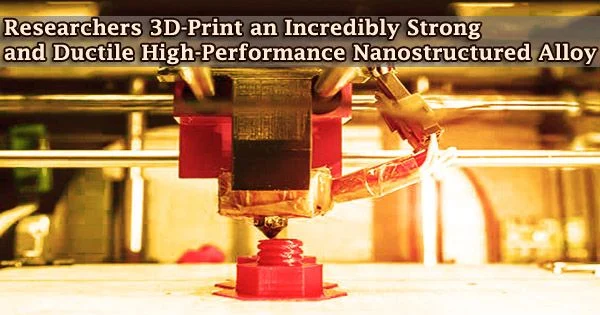A dual-phase, nanostructured high-entropy alloy that has been 3D printed by a team of researchers from the University of Massachusetts Amherst and the Georgia Institute of Technology is stronger and more ductile than other cutting-edge additively manufactured materials, which could lead to higher-performance components for uses in aerospace, medicine, energy, and transportation.
The work, led by Wen Chen, assistant professor of mechanical and industrial engineering at UMass, and Ting Zhu, professor of mechanical engineering at Georgia Tech, is published online by the journal Nature.
High entropy alloys (HEAs) have gained popularity as a new paradigm in materials science over the past 15 years. They allow for the creation of a nearly limitless number of different alloy designs because they are made up of five or more elements in nearly equal amounts.
Brass, carbon steel, stainless steel, and bronze are examples of traditional alloys that mix a principal element with one or more trace elements.
A potent method for material creation has just surfaced: additive manufacturing, generally known as 3D printing. Large temperature gradients and rapid cooling rates, which are not easily accessible by conventional means, can be produced using laser-based 3D printing.
However, “the potential of harnessing the combined benefits of additive manufacturing and HEAs for achieving novel properties remains largely unexplored,” says Zhu.
An HEA was combined with a cutting-edge 3D printing method called laser powder bed fusion by Chen and his team at the Multiscale Materials and Manufacturing Laboratory to create novel materials with unheard-of qualities.
Our simulation results show the surprisingly high strength yet high hardening responses in the BCC nanolamellae, which are pivotal for achieving the outstanding strength-ductility synergy of our alloy. This mechanistic understanding provides an important basis for guiding the future development of 3D printed HEAs with exceptional mechanical properties.
Professor Ting Zhu
Because the process causes materials to melt and solidify very rapidly as compared to traditional metallurgy, “you get a very different microstructure that is far-from-equilibrium” on the components created, Chen says.
This microstructure, which resembles a net, is composed of alternating layers of face-centered cubic (FCC) and body-centered cubic (BCC) nanolamellar structures that are encased in small, randomly oriented eutectic colonies. The two phases can cooperatively deform thanks to the hierarchical nanostructured HEA.
“This unusual microstructure’s atomic rearrangement gives rise to ultrahigh strength as well as enhanced ductility, which is uncommon, because usually strong materials tend to be brittle,” Chen says.
Compared to conventional metal casting, “we got almost triple the strength and not only didn’t lose ductility, but actually increased it simultaneously,” he says.
“For many applications, a combination of strength and ductility is key. Our findings are original and exciting for materials science and engineering alike.”
“The ability to produce strong and ductile HEAs means that these 3D printed materials are more robust in resisting applied deformation, which is important for lightweight structural design for enhanced mechanical efficiency and energy saving,” says Jie Ren, Chen’s Ph.D. student and first author of the paper.
Zhu’s group at Georgia Tech led the computational modeling for the research. To comprehend the mechanical roles played by both the FCC and BCC nanolamellae and how they cooperate to provide the material more strength and ductility, he constructed dual-phase crystal plasticity computer models.
“Our simulation results show the surprisingly high strength yet high hardening responses in the BCC nanolamellae, which are pivotal for achieving the outstanding strength-ductility synergy of our alloy. This mechanistic understanding provides an important basis for guiding the future development of 3D printed HEAs with exceptional mechanical properties,” Zhu says.
Additionally, 3D printing provides a strong tool for producing parts with intricate geometries.
Future direct manufacture of end-use components for biomedical and aerospace applications will have plenty of options thanks to the combination of 3D printing technology and the enormous alloy design space of HEAs.
Additional research partners on the paper include Texas A&M University, the University of California Los Angeles, Rice University, and Oak Ridge and Lawrence Livermore national laboratories.
















